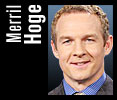Editor's Note: Former NFL running back Merril Hoge, who works as an analyst on "Edge NFL Matchup," "NFL 2Night," ESPN Radio and ESPN.com, breaks down how the New England Patriots upset the St. Louis Rams in Super Bowl XXXVI, 20-17.
Because the Rams and the Patriots had already met once during the regular season, I don't know if I could call Bill Belichick's Super Bowl game plan "masterful." Regardless of how great the Patriots' head coach's scheme was, the players ultimately had the biggest challenge, having to perform and execute the plan within a short period of time.
Belichick may be special at devising and creating schemes, but the New England players had to completely change their mind-set from stopping the Pittsburgh Steelers' smash-mouth style of play in the AFC championship game to stopping a St. Louis Rams team that likes to throw the ball to a variety of weapons. Both were enormous tasks, and the players did a tremendous job in successive weeks.
Here is how the Patriots were able to derail the Rams:
1. Preventing mismatches
The Patriots' primary plan was to not get outflanked. They were not going to let the Rams' passing game beat them. They tried to stay out of mismatches by gambling and playing five, six and even seven defensive backs at a time. They were able to match up with the Rams' receivers with better cover guys and more speed, and the defense never allowed the Rams to get on track. They disrupted their play. The secondary, led by Lawyer Milloy and Ty Law, was as physical and played as well as any group I've ever seen in football. They had the heads of the Rams' receivers on a swivel after about the first quarter.
2. Mauling Marshall
While the Patriots gambled with a multitude of defensive backs, the Rams played right into their hands. How? Even though the Patriots were forcing the Rams to run the ball, they didn't. With so many defensive backs on the field, the Rams should have attempted more runs, especially with Marshall Faulk, the game's best running back. Faulk should have carried the ball more than 17 times. At the same time, the Patriots covered Faulk and occupied him out of the backfield. They got into his head early in the game. They hit him, chipped him, knocked him off his patterns and broke his rhythm. While he finished with 130 total yards, Faulk never really got into the game, even when the Rams called his number. When the ball was snapped, Faulk got tattooed, whether he had the ball or not.
3. Getting more from Seymour
With their emphasis on stopping the pass and punishing Faulk on every play, the Patriots were asking a lot of their defensive line. And the Patriots' tackles stepped up big, in the running game and the passing game. Rookie Richard Seymour had a phenomenal game, with numerous pressures and big tackles. Seymour was the defensive player of the game. From a highlight standpoint, he may have gone unnoticed, but he made the difference up front.
4. Running at the Rams
New England's offense played a big role, using Antowain Smith to pound away at the Rams' defense and set the tempo of the game. Rather than focusing solely on scoring points, the Patriots tried to run at least five or six plays to create good field position. That was vital because it took time off the clock and forced the Rams' offense to always have to go 70-80 yards to score, instead of 45-55 yards.
5. Winning the final drive
On the 53-yard drive that set up Adam Vinatieri's game-winning 48-yard field goal, the Patriots worked the Rams' underneath coverage. They challenged the St. Louis linebackers, who broke down and failed to execute as they had all season. The biggest play of the game was the 11-yard pass from Tom Brady to J.R. Redmond on second down from the Patriots' 30-yard line. Brady checked down and hit Redmond on a flair route. Rams linebacker Tommy Polley slid out of his coverage responsibilities and was not in position to make the tackle. Redmond not only made the first down, but he also got out of bounds -- which was major. The Patriots also took advantage of Polley on another big play, the 23-yard completion to Troy Brown.
Keep in mind that, to beat the Rams and slow their offense, a team must have the same defensive skill players the Patriots have and a similar philosophy. The Rams treat every down like it is third down. After seeing what the Patriots did, other teams may think about playing more defensive backs on first and second down than they have in the past, but they run the risk of getting burned or outmanned up front.
I don't know if the Rams will allow teams to try the same scheme. Unless an opposing team feels like the Rams' three-receiver set is the formation of choice, I don't expect defenses to line up with six or seven defensive backs against the Rams. But if they do, the Rams will challenge it with their running game. The Rams didn't make the Patriots pay the price, but other teams may not be so lucky.


